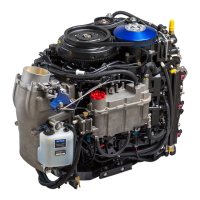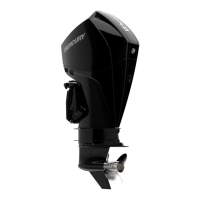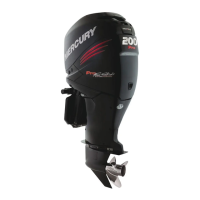•
Fuel pressure gauge. The PCM 112 does not monitor fuel pressure. It assumes that the correct pressure is available in
the fuel rails. Always use a gauge to verify that the pressure is correct before beginning more complicated diagnostics of
the fuel system.
Fuel Pressure Gauge Kit 91‑881833A03
•
Test probe kit. Do not use standard test probes to check the connectors; they could spread the pins apart and lead to
intermittent connections. Use the appropriate sized test probe leads included in the terminal test probe kit, or a suitable
alternative.
Terminal Test Probe Kit Bosch P/N MM‑ 46523
•
Known good fuel. A small tank of known good fuel can eliminate stagnant fuel as a source of the problem. If the engine
seems starved of fuel, but has good fuel pressure, ensure that the fuel is good.
Software and Adaptive Speed Control
Adaptive Speed Control is a feature included with the PCM 112. With Adaptive Speed Control, the PCM will strive to maintain
engine speed during turns or during trim events. This is part of the PCM's programming, and adds no working parts.
The following Live Data fields on CDS G3 apply to Adaptive Speed Control:
•
Demand refers to the demand requested by the software.
•
DemandLinear refers to the demand by the operator at the remote control. Therefore, the operator may have the throttle
(DemandLinear) at 60%, but because the boat is in a turn, Adaptive Speed Control (Demand) may be 70% to maintain
engine speed.
•
DemandLinear_with_Guardian reports the DemandLinear value less any Guardian limits. If the engine is operating
without any Guardian limits, both DemandLinear and DemandLinear_with_Guardian will be equal to each other. If the
engine is in Guardian, DemandLinear_with_Guardian will be less than DemandLinear, meaning the operator is asking for
more than the PCM will allow to protect the engine.
Load Balancing
Load balancing is the strategy developed to ensure torque balance and idle stability. The system adds or subtracts ignition
timing to allow an independent cylinder to carry more or less of the total load. Spark is added to weak cylinders, and subtracted
from strong cylinders to achieve a balanced load.
PCM 112 Important Information and Pinouts
Page 2A-4 © 2018 Mercury Marine 90-8M0146617 eng JULY 2018

